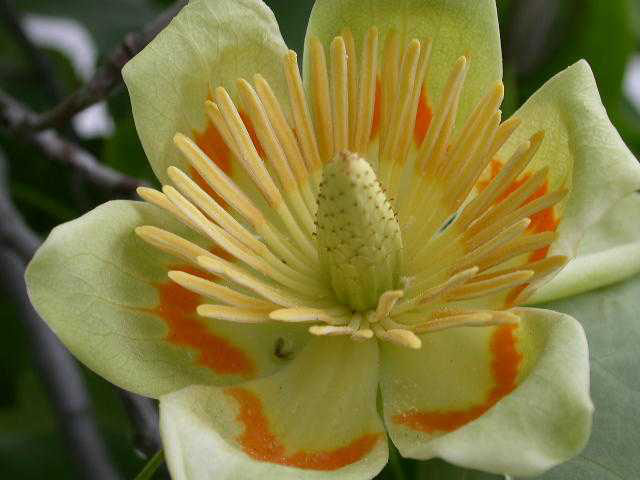Liriodendron tulipifera
 tulip tree
tulip tree
A handsome deciduous tree, one of the largest in the United States, that has been widely planted around campus since the late 1960s, it is immediately recognizable by its 6-inch leaves with a notch at the tip instead of the point that maple and plane leaves have. The notched leaf, which looks unusual and is certainly helpful in identifying the tree at a glance, can be thought of as bearing the same relationship to, say, a maple leaf that an even-pinnate leaf bears to an odd-pinnate leaf. In the case of the pinnate leaves the lobes of their ancestors have deepened to reach the midrib and veins. To those unfamiliar with the tree it is always a surprise to have the large, good-looking flowers pointed out; they are generally too high to reach but occasionally squirrels knock them down and you can puzzle over the curious innards. Owing to natural camouflage the flowers do not attract attention from a distance but are about 2 inches wide and high, carried upright like a tulip, and pleasantly colored in green, cream and light orange. A cluster of winged seeds is left standing erect on the stalks into the winter.
Tulip trees are at the north end of White Plaza; southeast of Memorial Church; between the Center for Educational Research and the Law School; and in the Law School courtyard. Peter Coutts Circle is tulip-tree heaven. A spectacular Palo Alto giant is at 1250 Lincoln Avenue.
Illustrations: flower (John Rawlings, ca. 2005) | leaf and fruit (From An Illustrated Manual of Pacific Coast Trees, Howard E. McMinn & Evelyn Maino).
About this Entry: The main text of this entry is from the book Trees of Stanford and Environs, by Ronald Bracewell, published 2005.





